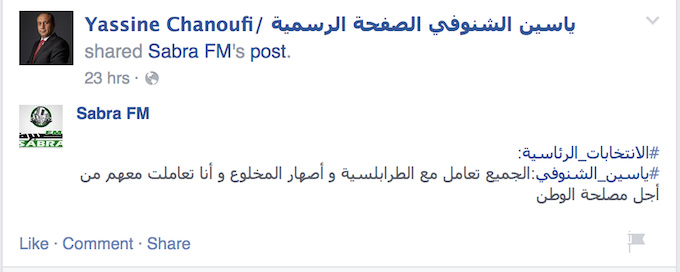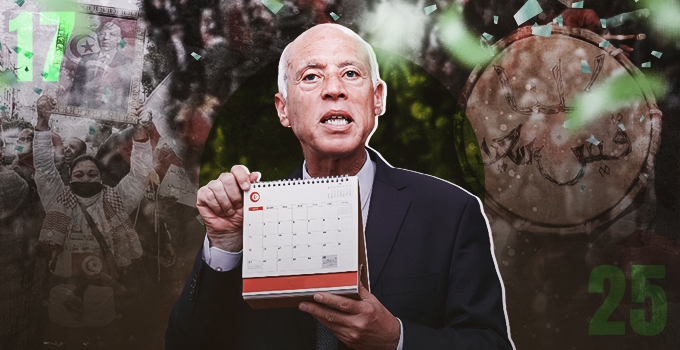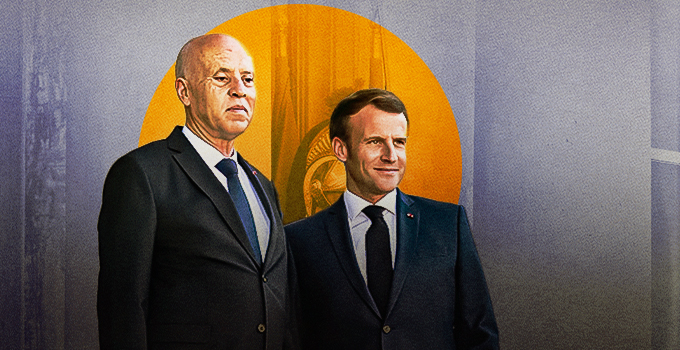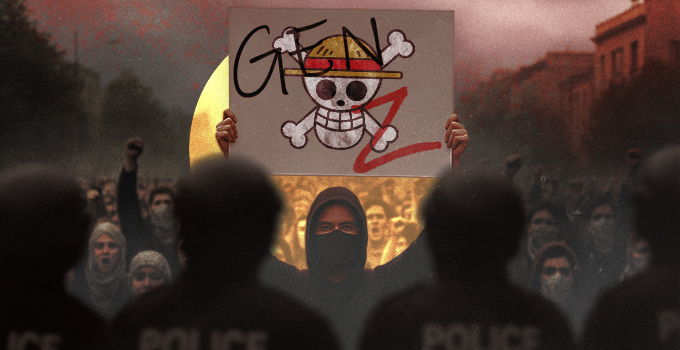Throughout this period of electoral campaigning, many of us pass, multiple times a day, in front of posters boasting the names and faces of the now twenty-two presidential candidates for the election this weekend. Invariably some of these political advertisements are more attention-grabbing than others. Nonetheless, this mode of political communication has more impact than meets the eye. In these first «free» presidential elections after decades of dictatorship, each presidential candidate seeks to claim or prove his own legitimacy. Aside from public speeches, meetings, and television appearances, the subliminal visual campaign of our candidates is designed to influence citizens at a subconscious level.
I- Campaign Posters, The Epitome of Political Marketing
Image-based communication has become a key factor in swaying public opinion. Implemented by some as a form of institutional propaganda, this «political marketing» utilizes advertising strategies to appeal to citizens. Playing on emotion rather than delivering information about clear political programs, campaign posters reflect a strategy that resonates with Talleyrand’s idea that
In politics, that which is believed becomes more important than which is true.
Charles-Maurice de Talleyrand Périgord
It is upon this sort of illusion that our candidates’ visual campaigns are built and aim to meet three main objectives: to craft one’s image and political platform in function with the electorate and to distinguish himself from other candidates. It must however be pointed out that posters representing Tunisia’s presidential candidates accomplish on average one out of the three objectives. Between those who diffuse their images throughout city streets—such as Beji Caid Essebsi whose posters evoke the popular figure of independent Tunisia’s first president Habib Bourguiba, and those—like Hamma Hammami or Slim Riahi—who titillate the electorate with discourse on social and economic issues, two contrasting visons emerge. In general, our candidates seem to minimize the impact of these images which have the potential to greatly influence the results of an election. The most striking example is that of Francois Mitterrand who, in his poster and campaign slogan for the 1981 election, combined the three factors effectively enough to completely reorient the direction of public opinion that had previously been strongly against him.
In order to better understand the design and impact of electoral posters, Nawaat met with Mr. Mohammed Ziyed Hadfi, principal associate at Tunis-Leaderschool, the first institute in the country that specializes in leadership training, communication skills, and counseling for business owners, politicians, and athletes. During our interview, Hadfi explained how these posters are put together and shared with us his impressions of those representing the twenty-two candidates in the running to become president of Tunisia’s new government.
II- Political Communication: A Fool’s Game

In this last phase of electoral campaigning, our presidential candidates have flooded television and radio stations to present their political programs. While some have limited public communication to a discourse concerning the constitionally-imposed attributes of a president—an approach of «politicking» that we associate with candidates such as Nourredine Hached, Mustapha Kamel Nabli (both of whom have withdrawn from the running), Mehrez Boussayene and even Kamel Morjane—others appeal to undecided voters with a discourse devoted to populist issues, and still others have made far-fetched promises that are well beyond their capacity to keep.
Beji Caid Essebsi and Bourguiban Paternalism
Beji Caid Essebsi seems to have grasped the psychology of Tunisian voters. As psycho-analysts Hechmi Dhaoui and Skander Boukhari explained to Nawaat, the Tunisian citizen is in search of a father figure, a trend that is confirmed a recent study conducted by the Institut Tunisie-Sondage; the study shows that 67 percent of Tunisians are basing their preference of presidential candiates on personality and filiation.
Essebsi seems to have recognized this trend and dedicated his campaign to evoking nostalgia for independent Tunisia’s first president, referring to him incessantly in his speeches and recalling at every opportunity his closeness with the «Father of modern Tunisia.» His campaign slogan is none other than Bourguiba’s idiosyncratic «fa bihaythou» (an expression of speech loosely translated as «thus» or «so»). Essebsi has also assumed the physical characteristics associated with Bourguiba—the style of clothing, the black sunglasses, the posture and body language, reviving in the collective subconscious the image of the country’s «supreme combattant.» Certainly such evocation of the past explains the impressive number of voters over the age of forty who preferred Nidaa Tounes in last month’s elections.
Marzouki, Chebbi, Ben Jaafar, and Fearmongering
These three presidential candidates have built their discourse around fears that the consolidation of power under a single party —Nidaa Tounes— will mean the return of the former regime. Having qualified the victory of Nidaa Tounes in the legislative elections as the result of a fear-based vote, Marzouki, Chebbi, and Ben Jaafar have attempted to discredit the party’s popular presidential candidate and portray him as a potential dictator. Largely limiting their platforms to this theme, these «revolutionary democrats» fall in the populist trap and have neglected to challenge the adversary on important issues such as the party’s political program (and have in the meantime also neglected to elaborate their own political programs).
Such communication tactics might have been effective at the time that Nidaa was formed in 2012, however, the deficiency of these parties’ platforms throughout the months leading up to elections has raised doubts about the competency and critical depth of the opposition. Their egos have led them to underestimate Nidaa Tounes, and, in so adamantly insisting on excluding them from the political scene, they have created a double discourse; it is likely too late in the game for these parties to embody the qualities of inclusiveness and unity that they claim to represent.
Political Money, Imposture, Populist Discourse, Media Hype
For other candidates such as Safi Said, unachievable promises and political money have been shining features of the political discourse. Advocating an Arab nationalism that lost its luster long ago, and wanting to isolate Tunisia from its national and international «enemies,» Said has relied on a populist discourse in order to appeal to voters in Gafsa and Kairouan. Worse, he has not hesitated to disparage political adversaries on his personal Facebook page.
Yassine Channoufi seems less a candidate for the presidency than for a leadership position at the district level. In his meeting at Bizerte, for example, he proposed rehabilitation projects for each city he visited—reconstructing Bizerte’s main bridge, turning the city into a tourist destination, among a number of initiatives that are certainly not the sort of priorities we attribute to the future president of the Republic. Calling for the pardoning of those who worked with the Trabelsi family, with whom he himself worked «in the interest of the country» (as he writes in the tweet below), Channoufi is lacking in sound political discourse.

Mohamed Frikha has without question tended to all of the material factors to promote his candidacy. Giant posters spread on walls throughout the capital and dominating the entrance to the Barcelone train station and an advertisement on social networks are evidence of a vast political campaign; its depth, however, was apparently not so well elaborated. Between attempts to win the much coveted vote of Ennahdha’s electorate, and frivolous promises in every city he visits, it is above all Frikha’s arrogance that will be his downfall in the elections.
The «Absents» of Electoral Media Hype
Some candidates are distinctive in their relative absence from the media craze that has overcome the capital. The first of this category who comes to mind is UPL candidate Slim Riahi. After legislative elections, one might have expected a wave of media hype around Slim Riahi for the presidential elections. Clearly this «golden boy» as his supporters call him has chosen sobriety over the elaborate nature of his party’s legislative campaign. Riahi’s team seems to believe that the success of his party in the legislative elections will be enough to carry him into the presidential runoff while avoiding criticism of «overdoing it». Riahi and his party would be mistaken to assume that this approach will suffice to maintain his success.
Hamma Hammami has led a similarly quiet campaign for the coming election. Generally refraining from participating in the «political theater,» of the past month or so, Hammami benefitted from his appearance on Nessma TV’s « La route vers Carthage » that inspired a positive reaction on social networks. Far from the limelight, Hammami has gained popularity through a campaign that earned the Popular Front a relatively good result in the legislative elections, and hopes to reach the presidential runoff by appealing to his voter base.
For a first presidential campaign and faced with the new challenge of pluralism, the 2014 electoral period thus far has been encouraging, though still far from the ideal of democracy to which citizens aspire. As Essebsi plays to Bourguiba nostalgia and «democrats» employ a discourse based on perpetuating fear that they themselves condemned in the legislative elections, as promise-makers advance numerous unachievable plans, it may just be that the «absents» of electoral media hype have done well to implement a relatively quiet campaign in the countdown to the presidential election.





iThere are no comments
Add yours